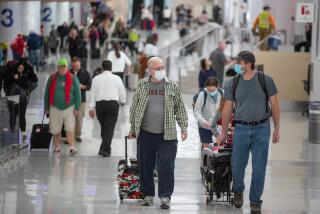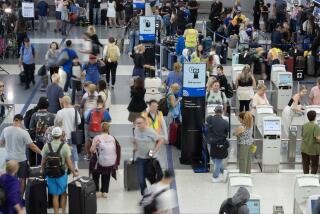Radar Problems Blamed for ‘Close Calls’ in Palm Springs
The radar at Palm Springs International Airport has proved so undependable that it has been shut down for the last 11 days--leaving technicians scrambling to make repairs, officials say.
The problem has led to six “close calls,” according to air traffic controllers.
For now, the controllers are unable to detect aircraft flying below 8,000 feet and are relying on radio communication and visual alerts--and are trying to keep aircraft separated by 30 miles--to avoid midair collisions.
The Federal Aviation Administration acknowledges the problem but insists that flying into Palm Springs remains safe.
Incessant problems with the radar were encountered after the system was installed 2 1/2 years ago, said Curtis Warren, the Palm Springs representative of the National Air Traffic Controllers Assn.
Among the problems, he said, were aircraft that simply disappeared from the radar screen, or whose blips jumped around on the screen, or whose altitude data were inaccurate.
The problem became so severe that the FAA--at the request of local controllers--shut the system down Dec. 19 for repairs.
“These are not glitches, but major systemic problems,” Warren said Thursday. “We’re not trying to fan the flames of hysteria, but safety has been compromised. It’s not as safe to fly now as it is when you have your radar working.”
FAA technicians are having trouble repairing the problem, said FAA spokeswoman Kirsti Dunn.
“We’ve got teams that have been working out there over the Christmas holiday and will be there over the New Year’s holiday,” she said. “They’re continuing to try to get the radar up and functioning, and are not having a whole lot of luck right now.”
But because greater distance is being put between airplanes, Dunn said, “It is absolutely safe flying into and out of Palm Springs.”
Air traffic controller Warren, however, said “safety is degraded” in part because smaller, private aircraft--including corporate jets--fly into Palm Springs’ airspace when they are landing and taking off from the nearby Bermuda Dunes and Thermal airfields.
Many of these planes, he said, do not have on-board radar allowing them to detect one another or to be detected by larger planes at Palm Springs.
In the past 11 days, he said, there have been at least 15 incidents where aircraft have avoided one another only because each had on-board equipment allowing them to detect the other.
Six recent “close calls,” said Warren, have involved planes without on-board radar.
Two of them involved commercial aircraft flying within half a mile--and perhaps within 400 feet--of smaller aircraft, Warren said. The incidents were reported by the pilots to the air traffic controllers, Warren said, but he was unsure whether they were later reported to FAA officials.
Warren said the Palm Springs radar system was constructed of “castoff parts” from other systems “that should have worked, on paper, but in fact don’t.”
Until the radar is repaired or replaced, controllers are allowing only one aircraft to fly into the 30-mile region at a time. Normally, aircraft are separated from one another three miles horizontally and 1,000 feet vertically.
“If this were a major metropolitan area--Los Angeles or Chicago or Washington--the FAA wouldn’t just be bringing in technicians,” he said. “They’d bring in new equipment overnight.”
The FAA could remedy the problem by spending $8 million to $10 million on a new radar system, Warren said.
“The local FAA people know the problem and have been nothing but supportive in trying to deal with it,” he said. “What we’re trying to do is get the attention of Washington.”
Warren said the 26 air traffic controllers are raising their concern publicly because of the FAA’s reluctance to buy new radar. “We’re not trying to grandstand,” he said. “We won’t get more pay out of this, or more benefits. We just want new equipment.”
He complained also that the controllers are working out of an airport trailer that was intended to be temporary when it was installed 2 1/2 years ago. “It’s such a rat’s nest of wiring and power lines that the technicians who have seen it were incredulous,” he said.
There have been some delays in scheduled passenger traffic arriving in Palm Springs, due partly to normal holiday slowdowns but also because of the increased separation between aircraft, said Jeri Riddle, the city’s director of aviation. She said there have been no complaints from the carriers.
The airport handles about 100,000 takeoffs and landings a year, generating about 1.3 million passengers.
More to Read
Sign up for Essential California
The most important California stories and recommendations in your inbox every morning.
You may occasionally receive promotional content from the Los Angeles Times.










